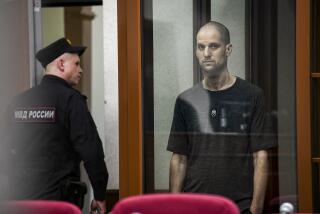U.S.-Israel Plot Charged in ‘Ivan’ Holocaust Case : War crimes: Little is said of new Soviet evidence that casts doubt on conviction of Demjanjuk.
- Share via
JERUSALEM — The appeals hearing of John Demjanjuk, accused of sadistically sending Jews to their deaths in a Nazi concentration camp, reopened Monday with the defense lawyer charging that his client is the victim of an American and Israeli plot and the prosecution complaining that the defense is doing the work of people who “hate Jews.”
Little was said directly about new evidence obtained from the Soviet KGB, which throws into question the conviction and death sentence handed down for Demjanjuk, a Cleveland auto worker from Ukraine. A lower court ruled that he is “Ivan the Terrible,” a camp guard who operated gas chambers at Treblinka, where the Nazis killed hundreds of thousands of Jews.
Yoram Sheftel, Demjanjuk’s lawyer, spent most of the long day claiming that his client was the victim of a “plot,” in which evidence was hidden by American and Israeli officials for 13 years.
“They knew who was Ivan the Terrible and who was not,” Sheftel said of American investigators. “It’s not only a question of the essence of the material, but it’s concealment.”
Prosecutor Michael Shaked denied any such conspiracy. He seemed to have lost interest in proving that Demjanjuk, who was stripped of his American citizenship and extradited to Israel in 1985, was ever at Treblinka.
Shaked instead spoke of the possibility that Demjanjuk was at other camps--Sobibor and Trawniki in Poland and Flossenberg in Germany--for Ukrainian prisoners of the Nazis.
The unwillingness of either the defense or prosecution to argue at length the significance of the new evidence forced the five member Supreme Court panel to call for yet another hearing in January.
Three years ago, Demjanjuk was convicted of war crimes and sentenced to death. But now the court faces the potentially embarrassing decision to acquit a man who had been judged without a doubt to be Ivan the Terrible.
And evidence gleaned from KGB files over the past 15 months and presented to the Supreme Court in August throws doubt on the conclusion that Demjanjuk was Ivan the Terrible.
Testimony from other guards, all of whom were executed in the Soviet Union for war crimes, gave the Treblinka guard’s name as Ivan Marchenko. Ivan the Terrible seems to have been captured by the Nazis and put to work in the camps at a different time than Demjanjuk.
The photograph of Ivan the Terrible differs markedly from a photo of Demjanjuk taken in the same years. A personnel file puts Ivan the Terrible’s age at 31 when he worked in the camps; the court accepted testimony that said Demjanjuk was in his early 20s.
In the original lower court trial, no documented proof, only the word of elderly survivors, placed Demjanjuk in Treblinka.
Sheftel claimed that the new evidence was more credible than the word of five witnesses, who he claimed were “coached.”
One judge, Eliezer Goldberg, objected that the new evidence does not necessarily override the eyewitness accounts. He asked whether “we should . . . accept these accounts over those of the survivors? It isn’t that simple.”
The judges appeared uninterested in the possibility that American officials hid evidence that might have derailed Demjanjuk’s extradition and trial. Sheftel claimed that American officials were in possession of evidence as early as 1978 and that it was passed to the Israelis. “What happened in the U.S. makes no difference,” asserted Judge Meyer Shapira.
Demjanjuk, 71, entered the court handcuffed and smiling.
Unlike the original trial, with its vivid descriptions of Nazi atrocities, Demjanjuk’s appeal is drawing little attention in Israel.
More to Read
Sign up for Essential California
The most important California stories and recommendations in your inbox every morning.
You may occasionally receive promotional content from the Los Angeles Times.










